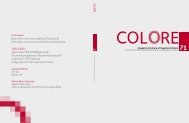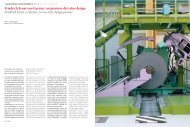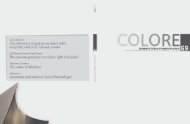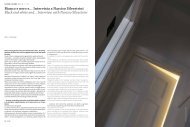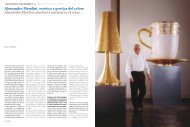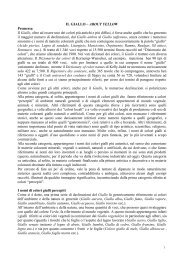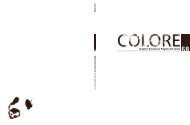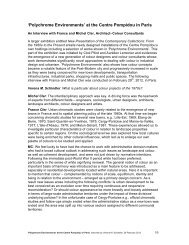Intervista a Giovanni Brino - Istituto Del Colore
Intervista a Giovanni Brino - Istituto Del Colore
Intervista a Giovanni Brino - Istituto Del Colore
Create successful ePaper yourself
Turn your PDF publications into a flip-book with our unique Google optimized e-Paper software.
CULTURA / CULTURE [ 1 2 3 4 5 6 (7 + 8) 9 ]<br />
Rosso e...intervista a <strong>Giovanni</strong> <strong>Brino</strong> / Red and...Interview with <strong>Giovanni</strong> <strong>Brino</strong><br />
Il Piano del <strong>Colore</strong> di Torino ha stimolato la realizzazione di una cinquantina<br />
di altri piani, fra cui quelli dei vari quartieri di Marsiglia, di molte<br />
città e villaggi in Piemonte e in altre città italiane, in Francia, in Svizzera<br />
e in Australia. I piani del colore hanno subito naturalmente una evoluzione,<br />
nel senso che sono stati sempre più orientati a diventare uno<br />
strumento di restauro conservativo delle facciate, grazie anche ai corsi<br />
di formazione ad essi collegati. In questo senso, il Piano del <strong>Colore</strong> di<br />
Torino è stato unico e irripetibile, trattandosi del ripristino, sia pure con<br />
i dovuti adattamenti e aggiornamenti, di un piano preesistente, in base<br />
a precisi documenti d’archivio, con i nomi dei colori delle facciate delle<br />
principali vie e piazze.<br />
Quali ricadute hanno avuto i “piani del colore” sul piano didattico, della<br />
ricerca, della professione e della formazione professionale?<br />
I piani del colore, le esperienze professionali di restauro di facciate<br />
storiche e di formazione professionale sui colori dell’architettura sono<br />
stati stimolati ed a loro volta hanno stimolato tutta una serie di ricerche<br />
sui colori condotte per quasi 40 anni con i miei studenti, nei corsi<br />
da me tenuti presso la Facoltà di Architettura di Torino e i cui elaborati<br />
sono gelosamente custoditi nel mio archivio. Le ricerche storiche e archivistiche<br />
(come si è visto nel caso del restauro della Casa Antonelli o<br />
del Piano del <strong>Colore</strong> di Torino, nelle “banche dati” dei restauri della Villa<br />
Medici a Roma o dei colori di altre città come Marsiglia, dove ho lavorato<br />
per 17 anni presso l’Atelier du Patrimoine, o la banca dati dei colori della<br />
Regione Piemonte o della Regione Liguria, solo per fare qualche esempio)<br />
sono sempre state sperimentate attraverso realizzazioni pratiche<br />
che, a loro volta, hanno generato e stimolato ulteriori approfondimenti.<br />
Come risultato di questi approfondimenti e ricadute, mi piace ricordare<br />
tre esperienze attualmente in corso.<br />
La prima ricaduta delle ricerche sui colori delle città e dell’architettura<br />
è costituita dal “Dizionario dei colori”, condotto con mia moglie Dominique,<br />
che a partire dalla fine degli anni ’70 ha sempre collaborato con<br />
me, e con Tom Porter. Questo dizionario è stato allestito a partire dalle<br />
ricerche d’archivio sui colori delle città indagati nel corso dei vari piani<br />
o banche dati o attraverso le ricerche universitarie o nelle tesi di laurea<br />
dei miei studenti.<br />
La seconda ricaduta riguarda le banche dati sui colori del Piemonte e<br />
della Liguria, di cui è in progetto la riedizione aggiornata dei libri sui<br />
colori di queste regioni, in cui si sono massimamente concentrate le<br />
ricerche archivistiche, le esperienze di restauro di facciate attraverso<br />
l’attività professionale ed i corsi di formazione.<br />
La terza ricaduta, infine, è rappresentata dalla sezione del “Prezzario<br />
della Regione Piemonte” sui materiali e prodotti tipici piemontesi, condotta<br />
in collaborazione con la Regione Piemonte e la CNA.<br />
Al di fuori dei piani del colore e dei restauri di facciate storiche, ha avuto<br />
anche qualche esperienza di colorazione di ambienti moderni?<br />
Come si è visto dall’esposizione delle esperienze da me condotte in questi<br />
40 anni, dal 1968 al 2008, non sono un “colorista”, come gli amici Jean<br />
Philippe Lenclos, Tom Porter o Jorrit Tornquist, tanto per fare dei nomi di<br />
personaggi che ho conosciuto personalmente e che stimo, facendo ormai<br />
parte della storia del colore, raccontata dagli stessi protagonisti.<br />
Come architetto, sono contento di aver avuto la possibilità di fare rina-<br />
together with the Sassello town council in Liguria (a miniature Genua<br />
Picta, in which all the façades are painted with the trompe-l’oeil technique),<br />
a real “Small village-Laboratory”, aimed at restoring ten or so<br />
façades, decorated as a theatre backdrop.<br />
How many colour plans have you carried out, after the Torino’s Colour<br />
Plan? And which evolution have they undergone in these last thirty<br />
years?<br />
The Torino’s Colour Plan has fostered the realization of about fifty other<br />
plans, among which those of Marseille’s various districts, of many<br />
cities and villages in Piemonte and in other Italian cities, in France, in<br />
Switzerland and in Australia. The colour plans have naturally undergone<br />
an evolution as they were more and more oriented towards becoming<br />
a tool for restoring the façades in a conservative way, also thanks to<br />
the training courses associated with them. In this sense, the Torino’s<br />
Colour Plan has been unique and exclusive, since it restored – although<br />
properly adjusted and updated – a pre-existing plan, following precise<br />
archive documents, with the colour names of the façades of the main<br />
streets and squares.<br />
Which type of repercussions had the “colour plans” on the educational,<br />
research, professional and training level?<br />
The colour plans, the professional experiences of the historical façades<br />
restoration and of the professional training on the architecture colours<br />
have been fostered by and, in turn, have fostered a whole series<br />
of colour researches, carried out along with my students for almost<br />
forty years, in the classes I have been teaching at Torino’s Architecture<br />
Faculty, and whose papers are jealously cherished in my archive. The<br />
historical and archive researches – as we have seen in the restoration<br />
of Casa Antonelli, in the Torino’s Colour Plan, in the “database” of the<br />
restoration of Villa Medici in Roma, in the colours of other cities such as<br />
Marseille, where I have worked for 17 years at Atelier du Patrimoine, or<br />
in the chromatic data base of the Piemonte or Liguria Region, to name<br />
just a few – have always been experimented through practical realizations<br />
which, in turn, have generated and promoted further in-depth<br />
studies. As a result of these closer examinations and repercussions, I<br />
like to mention three experiences currently in progress.<br />
The first repercussion of the colour researches of the cities and of the<br />
architecture is the “Colour Dictionary”, carried out with my wife Dominique,<br />
who has been working with me all these years since the late<br />
Seventies, and with Tom Porter; the project has been organized starting<br />
from the archive colour researches of the cities, carried out during the<br />
different plans or through databases or university researches or my<br />
students’ graduations thesis. This “Colour Dictionary” currently classifies<br />
over 15 thousand colour names, with their relative definitions, history,<br />
formulas, the Munsell’s and NCS’s colour-modelling system and<br />
the scientific denominations with the ISCC.NBS system, the synonyms,<br />
the places where they have been employed, etc.<br />
The second repercussion concerns the colour data bases of Piemonte<br />
and Liguria Region, through which we are working on an updated reissue<br />
of the books on colours in those regions, where the archive researches,<br />
the experiences of façades restoration through the professional<br />
activity and the training courses were concentrated.<br />
16<br />
COLORE



